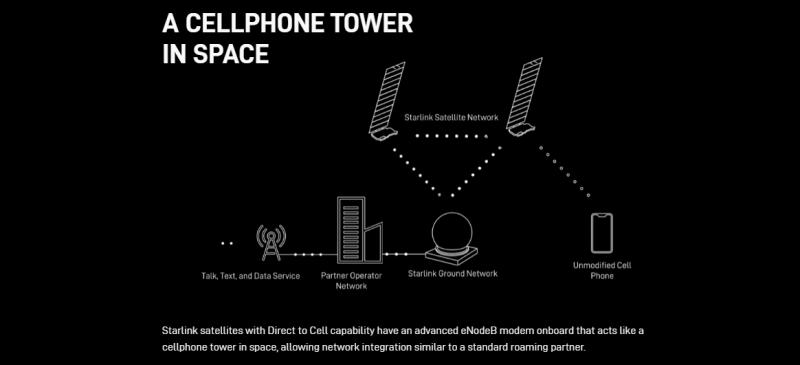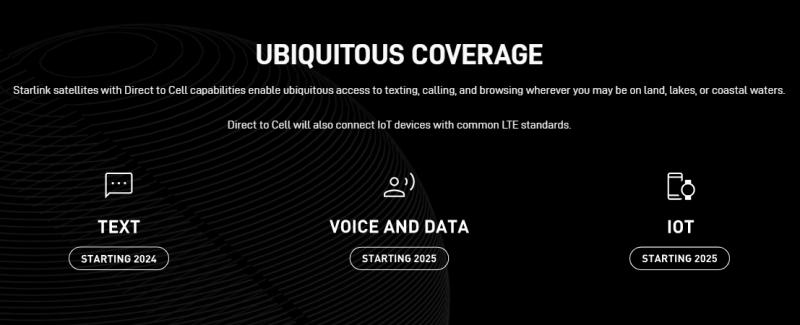It’s called Starlink Direct To Cell and it’s a service Starlink plans on rolling out in 2024. Since last year, we have seen the flagship smartphones from Apple and Huawei add direct satellite communication to their devices allowing them to send SMS messages via satellite.
Qualcomm later also announced that it would be adding satellite communication to its latest flagship chipset, the Snapdragon 8 Gen 2, allowing the feature to be available on all smartphones running the chipset. So it’s a technology that has already hit the ground running.
How it will work
The Tech
Starlink already has Low Earth Orbiting (LEO) satellites hovering close to the earth’s surface. These are currently providing internet services provided you have a Starlink terminal (antenna) and the service is available in your area.
The Direct To Cell service Starlink is working on will use versions of these satellites with an LTE eNodeB module on them. An eNodeB is a standard base station and communication protocol for mobile communication. So to your phone, the satellite is just another LTE base station. This is the crucial part because it means that you don’t need any extra hardware or modified software on your smartphone for you to be able to connect to the Starlink satellite.
Direct to Cell works with existing LTE phones wherever you can see the sky. No changes to hardware, firmware, or special apps are required, providing seamless access to text, voice, and data
Starlink
Unlike the solutions from Apple and Huawei that require your phone to have specific hardware to be able to connect to a satellite, the eNodeB-enabled Starlink satellites will provide a standard LTE connection that any LTE-enabled phone can connect to right now. Whether it’s a $200 Tecno or a $1,000 dollar iPhone. If it has 4G, it will work. This setup is part of the Non-Terrestrial Networks that we talked about in detail in a previous article.
The implementation
Since this will be an LTE communication system, it means you will need a SIM card for calls, SMSs and data to be routed. But Starlink will not be selling SIM cards. They will instead be partnering up with a local service provider who will integrate its mobile network with the Starlink Direct To Cell system.
This way, the existing mobile operator will have a customer base and accounts that then get satellite communication as an add-on to their already existing mobile plan.

A mobile operator already has an existing network. They then plug this network into the Starlink network through Starlink’s ground station which then provides the mobile operator with access to Starlink’s eNodeB (LTE) satellite network. So to the subscriber of this mobile operator, it’s all just network coverage. The subscriber will not know if they are connected to a terrestrial base station or a Starlink LTE satellite.
At the moment, Starlink has partnered up with 6 operators in 6 different countries.
- T-MOBILE (USA)
- OPTUS (AUSTRALIA)
- ROGERS (CANADA)
- ONE NZ (NEW ZEALAND)
- KDDI (JAPAN)
- SALT (SWITZERLAND)
The Direct to Cell service will initially offer text when it is rolled out in late 2024 with voice, data, and IoT device support slated for 2025.

A couple of FAQs
Once a mobile operator integrates with Starlink’s Direct to Cell service, they will, in theory, have 100% network coverage in the region in which they operate. So in as much as Starlink has Global coverage, the limitations that currently exist with mobile operators with regards to their region of operation will still exist. If you go to another country you will need to activate roaming.
Direct to Cell service, just like any other satellite-based communication system, works best when the device has a clear view of the sky. So such a service will not work indoors.
Potential solution to Africa’s connectivity challenges
We have spoken a lot about how Starlink’s satellite internet service is a true gem for those living in the remote parts of Africa who need reliable and affordable internet. Whilst this is still true, the barrier of entry is very high looking at the cost of the kits. In countries where the service is available in Africa, they are retailing for around US$500 with monthly subscriptions averaging US$50. And it’s restricted to just the internet.
Direct to Cell is a more approachable solution especially for the marginalized parts of Africa as all you need is a SIM card and an LTE-capable smartphone. All of which can be less than $150. Such a service can mean that a mobile operator can instantly capture a sizeable chunk of the rural population which for Africa sits at 57% of the continent’s population. And for Zimbabwe, that rural population is 67% of the total population.
In as much as Starlink is facing some legislative resistance in some markets, there are some interesting opportunities it is proposing towards bridging that digital divide in what seems to be very meaningful ways.
Also Read:
- 5G is terrible right now. But it has a very useful and exciting future
- Tell your MP that this is why people are excited about Starlink – access, affordability, reliability
- AMN using Starlink to expand mobile networks in underserved parts of Africa
- Who faces the biggest threat from Starlink? It’s not the MNOs

26 comments
Kkkkk thats we are going back to standard coz partnering with econet or netone will not change the price of data packages
So Edwin in simple terms this means if Econet, NetOne and Telecel partners with Starlink then there’s no need for the service providers to erect base stations anymore since they will be transmitting signal via the satellite?
Yes and no. So yes service will now be available wherever the sun touches. But it’s still not as resilient of a connection as what you get from ground mounted base stations. So for indoor operation there is still a case for a regular base station.
But in remote places with a clear view of the sky, a base station will be gladly replaced by these forms of satellites
New setup of buildings with clear roofing might be in the offing soon.
😂😂fu
Starlink should be licensed in Zimbabwe. It’s an innovative product.
Thanks for this beautiful article
I used to think that the radios in our mobile phones have ranges as far as connecting to base stations. Are we (or Starlink) saying the base stations were the limiting factors or hardware and the ones on their satellites can cast their signals very far and be able to reach the phones?
Range is limited for base stations and phones, but on the ground, there is rarely clear line of sight. I think these groups working on this type of technology are leveraging both better hardware and the physics to be able to transmit and receive signals just strong enough to render a useable service in the open. That’s why service under cover is not assured and why any providers that partner up with them won’t use this as the primary network
people must vote for ZANU PF
Good analysis.
It must noted where the eSIM comes in.
So it appears MNO are pretty safe and sound because of their interconnectivity direct with Starlink.
Now I am thinking 💭 wow this a God send for VoIP.
eSim seems irrelevant to this. As long as you are a valid subscriber on a network that has signed up with StarLink and you are using a 4g device, you should be fine. Once it is working, you won’t have to do anything special on your part including changing SIM.
Just remember that by their own projections, it will take a couple of years to ramp up to voice and data. Elon time is also a factor so you might want to double that mentally just in case.
026035/0615
You better out a disclaimer Edwin you almost gave these network operators a heart attack
Lol
kkkkkk
kkkkkk
Hopefully, this gets at least one of them to lobby for StarLink to be let in. When this service is fully online, the first network to sign on will have a unique advantage of true national coverage.
people must thank the visionary leadership of ZANU PF for bringing in this innovative technology to Zimbabwe
Not going to do that lol
This will be quiet difficult to implement as it will result in significant battery drain in smartphones that will be using the service, the uplink will require a significant amount of power, it might be useful for less data intensive situations eg SMS but I don’t see us using the service to upload a video to YouTube or TikTok.
Telecel should hop onto this.
ASAP
Am gonna stop using mobile phones which kind juju be this? The moment one connect his phone to starlink his privacy is compromise .. institution, government officials, country,continent.. everyone will not be safe…true talk people
You could, but what privacy do you realistically have now that you’d lose to StarLink? Your network still sees everything and can just as easily hand that over to Gov. All traffic in the clear is still being tracked and traded by multiple parties, some commercial, some state actors. Location either by crude triangulation, precise gps, mapped WiFi networks, Bluetooth handshakes between other phones and distributed tracking networks for tags… it’s all known and above board! Then we get into signals intelligence from every country that can afford it that’s just hoovering every scrap of data so that if/when you become a person of interest, everything about you can be looked up down to where you were 10 years ago and what you typed that day. That’s if that process isn’t already automated already by algorithms!
Jumping overboard is always an option, but the privacy ship set sail long ago and is in the middle of a vast sea of interests.
How can we avail the starlink satelite internet?
That marvelous innovation